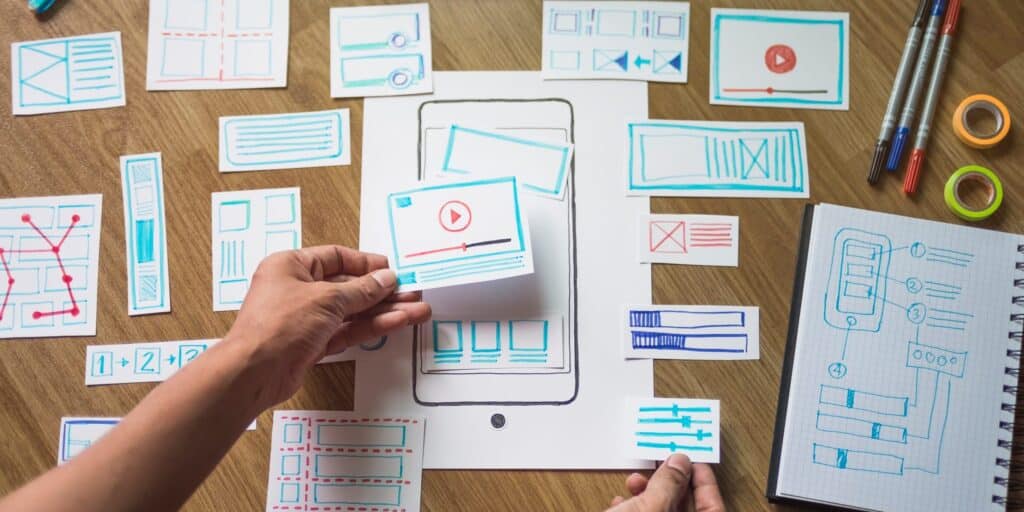
How You Can Sharpen Your UI/UX Design Skills?
User experience (UX) and User Interface (UI) design are two of the most in-demand skills in the tech industry. Companies are looking for designers who can create products that are not only user-friendly but also visually appealing. If you’re considering a career in UX or UI design, or if you’re already working in the field and want to sharpen your skills, then this article is for you. In it, we will explore some of the best ways to improve your UX/UI design skills. So, if you’re ready to take your design skills to the next level, read on!
Table Of Content
- Learn the Fundamentals
- Focus on the Details
- Stop being a perfectionist & Expand your design knowledge
- Step Out, Get Out of your way
- Keep up with the latest trends
- Create a portfolio to showcase your work
- Learn to grab feedback from other designers and developers
- Learn from experts & Reach out to them
- Have a mentor to guide you through Design Process
- Takeaway: You don’t have to be a master to improve, but you do need to learn new skills and get some feedback.
- Final Verdict
Learn the Fundamentals
The most important thing you can do is to be able to differentiate between the user interface and user experience. The user interface is the visible parts of your app and how it looks, including buttons, forms, and other navigational elements. User experience is everything else — how the app feels and behaves, from the moment a user opens it to the last interaction they have with it.
The user interface doesn’t matter if you don’t have a good user experience!
Focus on the Details
Focus on the details. This is a big one. If you want to get your message across, you need to know what it is you’re trying to say and how best to say it.
Know Your User — The first step to understanding your users is to actually talk to them. You can do this by asking them questions, or even better listening. Asking questions is a great way to get feedback on what you’re building, and it’s also a great way to dig into the details of what they care about.
Know Your Target Audience — Once you’ve figured out who your users are, it’s important that you know why they use your product or service in the first place especially if it’s not obvious from their behavior on other platforms or in other apps. This will help guide your design decisions and help ensure that you’re building something that appeals specifically to them rather than just creating something that looks good but isn’t useful enough for users’ daily lives.
Researching with human-centered methods — It can help you understand your users better. A good example is user testing; this involves having participants use the product or service while being observed by a research team. The goal is to observe how people use it, what they like and don’t like about it, and how they react to various things.
Tuning your senses — will help you create an experience that people want to engage with. Make sure that everything you create has:
- A clear message (what it is and what it does)
- An accessible style (does it look good?)
- A compelling value proposition (why should someone buy it?)
Stop being a perfectionist & Expand your design knowledge
If you’re someone who is constantly striving for perfection, you may want to consider expanding your design knowledge to include UI/UX design. UI/UX design is all about creating user-friendly and visually appealing interfaces and experiences. By learning more about UI/UX design, you’ll be able to create designs that are not only aesthetically pleasing but also user-friendly and functional.

It’s alright if you’re still a beginner in UI/UX. You can still start practicing the basics of UI/UX design. There are a number of online resources and tutorials that can help you get started. Once you have a good understanding of the basics, you can start experimenting with more advanced concepts. Remember, there’s no need to strive for perfection. Just focus on creating designs that are user-friendly and visually appealing.
Step Out, Get Out of your way
There’s no doubt that creativity and innovation are essential skills in the workplace. But how can you improve your creativity and ideation skills? Studying design principles might help you get started or go deeper. And then, make a point of stepping out of your comfort zone on a regular basis. This could involve trying new things, meeting new people, or simply exposing yourself to new ideas and perspectives.
By pushing yourself to experience new things, you’ll open yourself up to new possibilities and ways of thinking, which can only improve your creativity and ideation skills.
Keep up with the latest trends
In order to keep up with the latest trends in UI/UX design, it is important to learn how to adapt to new design software. This can be done by attending workshops, taking online courses, or simply experimenting with new software on your own.

Additionally, it is helpful to find inspiration from other designers. This can be done by following design blogs, attending industry events, or simply observing the world around you. By staying up-to-date with the latest trends and finding inspiration from others, you will be able to create unique and innovative designs that will stand out from the rest.
Create a portfolio to showcase your work
A portfolio is an important tool for any UI/UX designer. It is a great way to show off your skills and talents. It allows you to showcase your work to potential employers and clients, and can help you land your dream job or project.
When creating a portfolio, be sure to include your best work. Choose projects that you are proud of and that showcase your skills and talent. Include a mix of personal and professional projects, and be sure to include a link to your online portfolio in your resume and cover letter.
If you are just starting out in your career, you may not have a lot of work to include in your portfolio. In this case, you can include class projects, mockups, and personal projects. Be sure to include a description of each project, and what role you played in the design process.
Learn to grab feedback from other designers and developers
Getting feedback from others is a great way to improve your UI/UX design skills, it’s important to get feedback from other designers and developers. Feedback can help you improve your designs and make them more user-friendly. So don’t be afraid to ask for feedback and use it to improve your designs.
There are a few ways to get feedback from others. One way is to join a UI/UX design group or community and ask for feedback on your designs. Another way is to post your designs on design forums and ask for feedback.
Learn from experts & Reach out to them
There are many reasons to learn UI/UX design from experts. For one, UI/UX design is a complex and ever-changing field, so it’s important to stay up-to-date on the latest trends and technologies. Additionally, experts can provide insights and perspectives that you may not be able to find on your own.
Reaching out to experts can also be beneficial for your career. If you’re looking to break into the field of UI/UX design, connecting with experts can help you learn about job opportunities and make important industry connections. Even if you’re not looking for a new job, building relationships with experts can help you keep your skills sharp and expand your network.
Have a mentor to guide you through Design Process
If you’re considering a career in UI/UX design, or are already working in the field, consider finding a mentor to guide you through the design process. The benefits of having a mentor are numerous. A mentor can provide guidance and support, help you develop new skills and knowledge, and introduce you to new opportunities.
A mentor can help you hone your skills, keep you up to date on industry trends, and provide valuable insights and also offer advice and feedback, and help you stay motivated and on track.
Takeaway: You don’t have to be a master to improve, but you do need to learn new skills and get some feedback.
Being a great UI/UX designer requires continuous learning and evolution. As new technologies and trends emerge, it’s important to be able to adapt and learn new skills.
Getting feedback from others is also critical in order to improve your designs. By soliciting feedback from colleagues, clients, and users, you can gain valuable insights that will help you refine your designs.
Final Verdict
If you have read this far, I really appreciate it. I hope you enjoyed reading this article on “How You Can Sharpen Your UI/UX Design Skills?”, If yes, then don’t forget to spread the word about it Click your favorite social media icon below to share this content. Signing off sowmiyavenkatesan611@gmail.com






